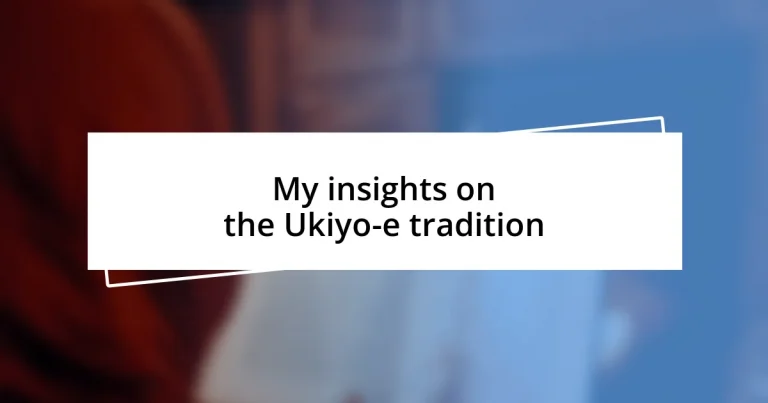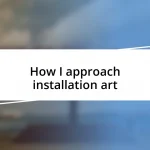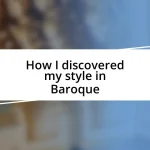Key takeaways:
- Ukiyo-e, meaning “pictures of the floating world,” originated in the Edo period and captures the vibrancy of urban life, daily experiences, and nature.
- Key artists like Hokusai and Hiroshige revolutionized Ukiyo-e with innovative techniques and emotional depth in their works, influencing both Japanese and international art.
- The intricate woodblock printing process involves careful carving and aligning multiple blocks to achieve depth, vibrant colors, and the essence of the Ukiyo-e tradition.
- Thematically, Ukiyo-e explores daily life, nature’s beauty, and mythology, preserving cultural narratives and evoking emotional connections through art.
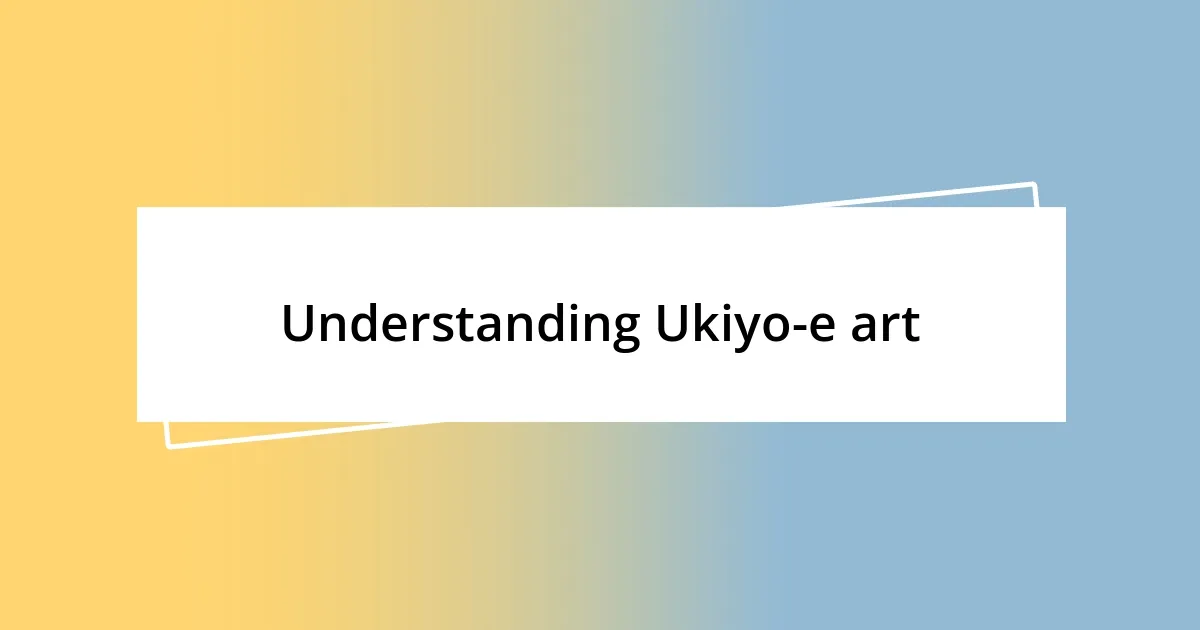
Understanding Ukiyo-e art
Ukiyo-e, often translated as “pictures of the floating world,” reflects a unique perspective on beauty and life in Edo-period Japan. This art form captures fleeting moments—whether it’s the vibrant hustle of kabuki theater, serene landscapes, or the intimate lives of courtesans. I remember the first time I encountered a Ukiyo-e print; it was a vivid depiction of cherry blossoms against a serene backdrop, and I found myself lost in the delicate details of each petal, feeling the transient beauty these prints strive to communicate.
What truly fascinates me about Ukiyo-e is how it blends artistry and storytelling. Each piece is like a window into a world brimming with emotion and culture, inviting viewers to reflect on their own experiences. Have you ever felt transported by art? I felt that when I studied a print showcasing the bustling streets of Edo, where the vibrancy of daily life resonated deeply within me—a reminder of the beauty in everyday moments.
The techniques used in Ukiyo-e, such as woodblock printing, are also worth noting. They reflect a remarkable combination of skill and creativity. I often think about the artists who meticulously carved their designs into wood, layer by layer, to create something that would endure through centuries. It’s a testament to human expression, isn’t it? Each print tells a story, whispering the sentiments of its era through the hands that brought it to life.
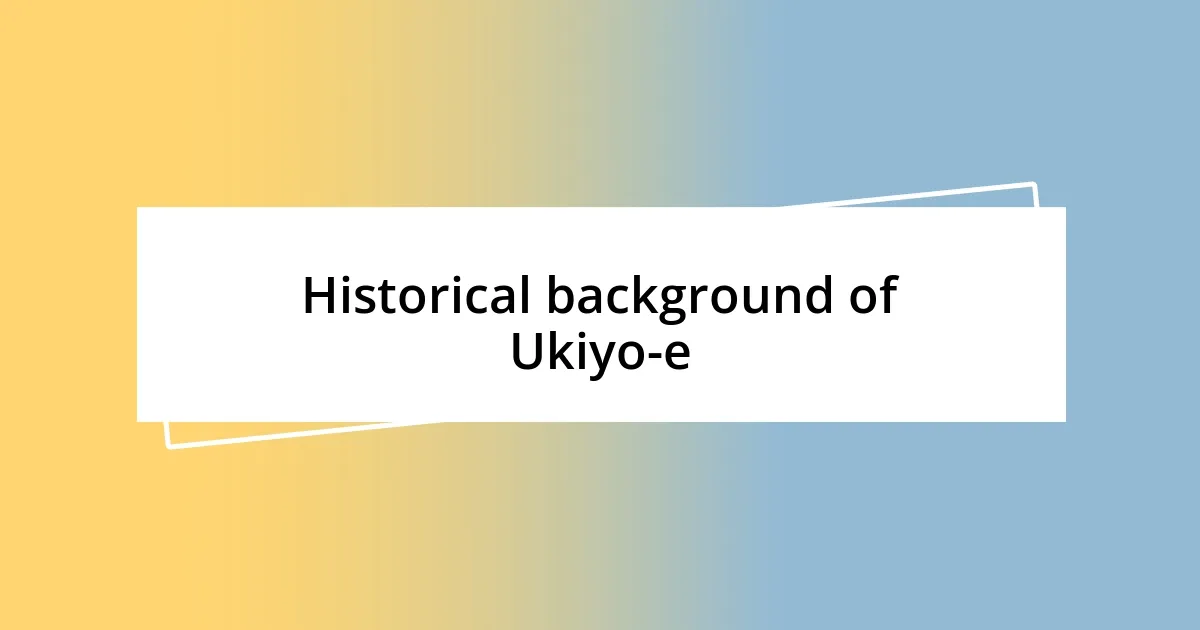
Historical background of Ukiyo-e
Ukiyo-e originated during the Edo period, around the 17th century, emerging as a popular art form among the merchant class. This societal shift toward urban culture allowed artists to depict the vibrant life of cities like Edo (now Tokyo) through their prints. I often think about how revolutionary this was, giving a voice to people outside of the traditional elite classes. Imagine being part of a culture where even the day-to-day life of the common person could be immortalized and appreciated.
As the genre evolved, it became a significant aspect of Japanese culture, influencing not only art forms within Japan but also attracting attention worldwide. My encounter with a Ukiyo-e print showcasing Mt. Fuji changed my perception of landscape art entirely; I felt the serene presence of the mountain captured in a way that invited contemplation. This particular piece connected me to the spirit of Japan’s natural beauty and the artists who sought to harmonize it with everyday life.
The intricacies of Ukiyo-e are mesmerizing. Artists like Hokusai and Hiroshige embraced innovative techniques, sometimes incorporating Western perspectives into their work. I remember studying one of Hokusai’s series and being struck by the layers of emotion conveyed through color and composition. Each print seemed to breathe with life, showcasing both immediate experiences and the deeper philosophies of existence, a reflection that resonates deeply with me.
| Period | Significance |
|---|---|
| 17th Century | Birth of Ukiyo-e during the Edo period, capturing urban life. |
| 19th Century | Expansion of Ukiyo-e’s influence outside Japan, gaining international fame. |
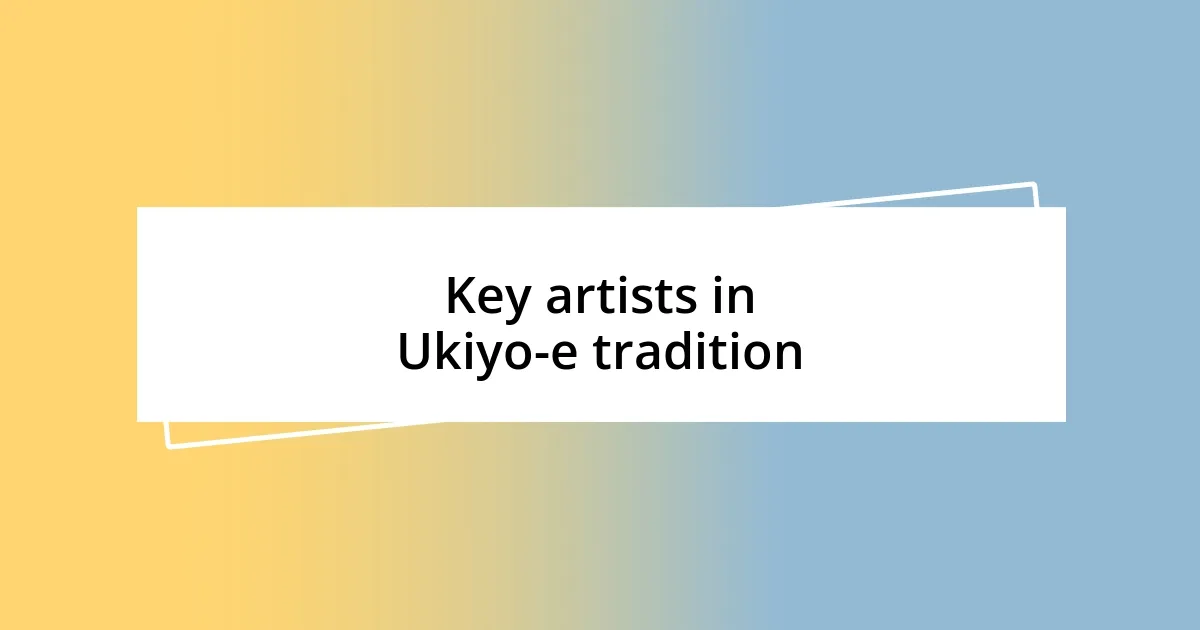
Key artists in Ukiyo-e tradition
The Ukiyo-e tradition boasts several key artists who have left an indelible mark on this art form. Each artist brought their own unique vision and techniques that helped shape the genre. For instance, Hokusai is perhaps the most celebrated, known for his iconic series “Thirty-Six Views of Mount Fuji.” I recall visiting an art museum where one of his prints was displayed, and standing there, I felt a deep sense of connection to nature—a reminder of how art can transcend time and space.
Here’s a list of some pivotal artists in the Ukiyo-e tradition:
- Katsushika Hokusai: Renowned for his dynamic compositions and masterful use of color.
- Utagawa Hiroshige: Celebrated for his landscape prints and his ability to depict fleeting moments with stunning detail.
- Kitagawa Utamaro: Known for his beautiful portraits of women, capturing their grace and everyday lives.
- Utagawa Kuniyoshi: Famous for his striking images of warriors and mythical creatures, combining fantastic elements with realism.
- Toshusai Sharaku: Recognized for his bold, expressive portraits of kabuki actors, showcasing their dramatic performances.
Each of these artists embodies a different aspect of the Ukiyo-e tradition, drawing me back to my own experiences exploring their works. The more I delved into their biographies and artistic journeys, the more I appreciated the profound personal and cultural narratives they shared through their prints. It’s like peeling back layers of history, revealing the passions and challenges these creators faced while immortalizing their world on paper.
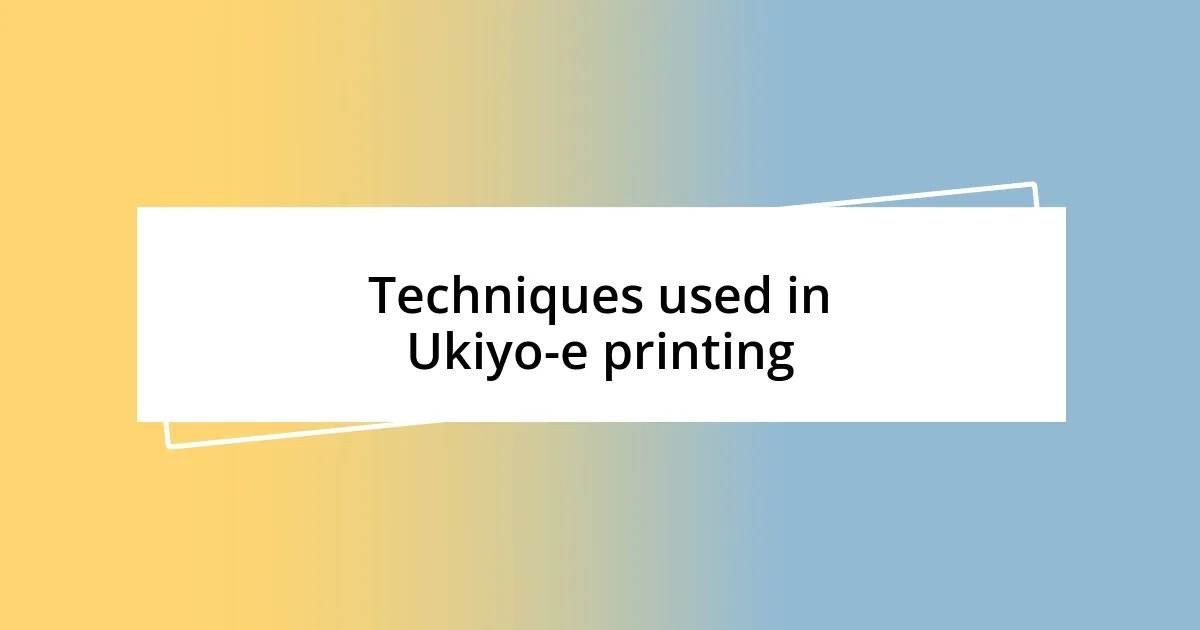
Techniques used in Ukiyo-e printing
The techniques used in Ukiyo-e printing are both intricate and fascinating. The traditional method starts with careful woodblock carving, where artists would draw their designs onto a piece of wood and then painstakingly carve it, leaving behind the raised areas that would later apply ink. I remember watching a skilled artisan demonstrate this process and feeling the artistry behind each cut; it was as if they were breathing life into the wood itself.
Once the blocks are carved, the printing begins—a process that can involve multiple blocks for different colors. Each block is aligned precisely, ensuring that the colors match perfectly, which I’ve always found to be a remarkable feat of patience and precision. It amazes me how prints can achieve such depth and vibrancy, almost like layering emotions. Have you ever seen a print where the colors seem to pull you in? That’s the magic of color registration and the use of natural pigments, which were often derived from minerals and plants.
Finally, there’s the pressing stage, where paper is applied to the inked blocks, often using a special tool called a baren. This part always evokes a sense of anticipation for me; I remember the first time I held a fresh print—it felt almost like uncovering a secret world. The soft texture of the paper held the impressions of the woodblocks, capturing the very essence of the Ukiyo-e tradition. It’s all about connection and creation, deeply rooted in a process that has resonated through centuries.
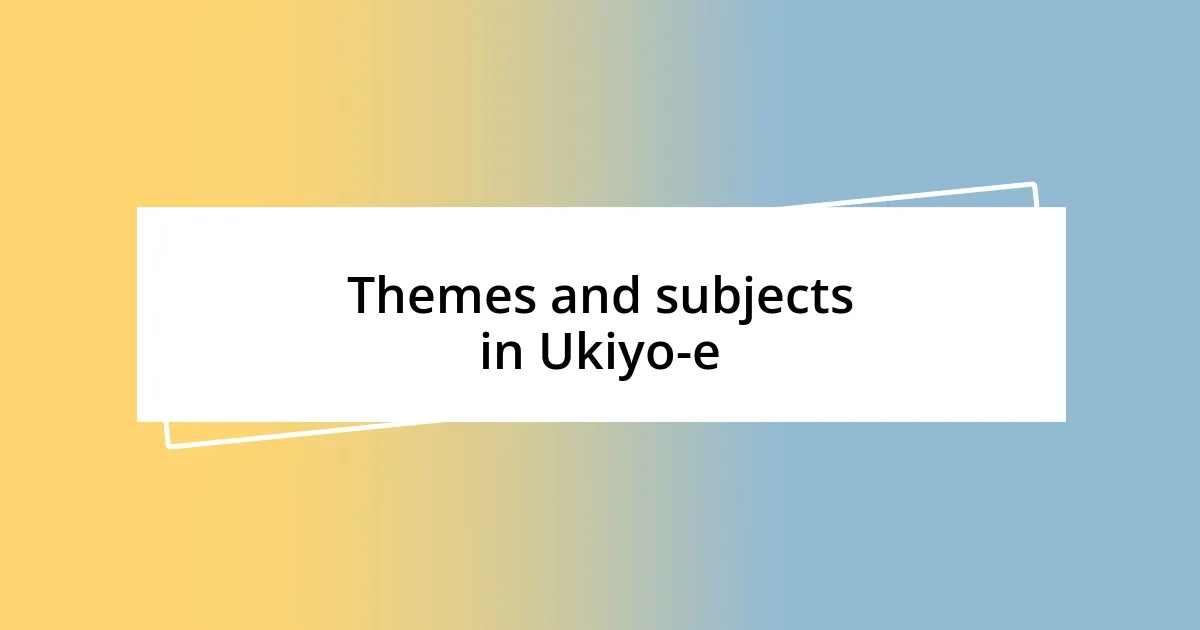
Themes and subjects in Ukiyo-e
Themes in Ukiyo-e are as diverse as the artists themselves. One prominent subject is the daily life of the Edo period, capturing scenes of leisure, entertainment, and work. I remember flipping through a book of prints and being transported to bustling kabuki theaters or serene tea houses. It felt like a window into another world, where each image told a story of the people and their moments in time.
Nature also plays a central role in Ukiyo-e, with stunning landscapes that celebrate the beauty of seasons and the environment. Take Hokusai’s “The Great Wave off Kanagawa,” for instance. Every time I see that print, it stirs a deep sense of awe and reverence for nature’s power. Have you ever stood before a piece of art that made you feel so small yet so connected to something greater? That’s the essence of Ukiyo-e—its ability to evoke emotions tied to natural beauty and movement.
Lastly, Ukiyo-e often explores the realm of mythology and folklore, depicting heroic figures and supernatural beings. Kuniyoshi’s warriors, for example, pull you into tales of bravery and adventure. When I first viewed one of his prints, I was captivated by the energy it exuded. It’s fascinating to think about how these narratives reflect not just the imagination of artists but also the cultural values of their time. Isn’t it incredible how art can preserve the stories of the past, making them resonate with us today?
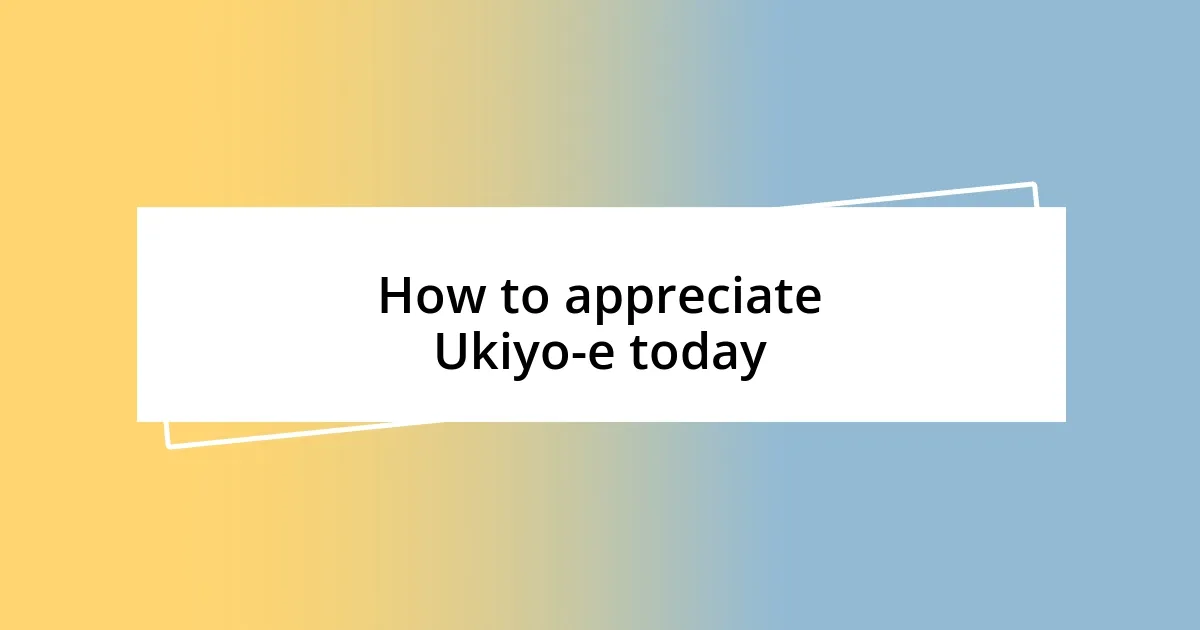
How to appreciate Ukiyo-e today
To truly appreciate Ukiyo-e today, I find that immersing myself in the context is key. When I first encountered these prints in a quiet gallery, I was struck not just by the visuals, but by the historical narratives woven into each piece. Think about how much life was happening in Edo Japan while these scenes were being created! It’s an invitation to step back in time and consider the stories each artist intended to share.
Exploring Ukiyo-e through its themes can enhance our appreciation further. For instance, when I examined prints depicting seasonal changes, I felt an emotional connection to the natural world. Isn’t it amazing how these artists captured fleeting moments in time so vividly? Each print resonates beyond its surface, reminding me of my own encounters with nature, like the serenity of watching cherry blossoms fall.
Finally, engaging with contemporary adaptations of Ukiyo-e can provide fresh perspectives. I once attended an art show showcasing modern interpretations, where familiar elements were combined with contemporary styles. It sparked a discussion with fellow attendees about how these age-old themes still hold relevance today. Have you ever looked at a modern piece and felt echoes of the past? The dialogue between centuries can deepen our understanding and foster a greater love for this beautiful tradition.












